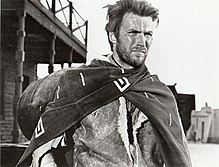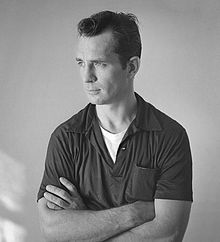Antihero

An antihero (sometimes spelled as anti-hero)[1] or antiheroine is a main character in a story who lacks conventional heroic qualities and attributes such as idealism, courage, and morality.[1][2][3][4][5] Although antiheroes may sometimes perform actions that are morally correct, it is not always for the right reasons, often acting primarily out of self-interest or in ways that defy conventional ethical codes.[6]
History[]

An early antihero is Homer's Thersites.[7]:197–198 The concept has also been identified in classical Greek drama,[8] Roman satire, and Renaissance literature[7]:197–198 such as Don Quixote[8][9] and the picaresque rogue.[10]
The term antihero was first used as early as 1714,[5] emerging in works such as Rameau's Nephew in the 18th century,[7]:199–200 and is also used more broadly to cover Byronic heroes as well, created by the English poet Lord Byron.[11]
Literary Romanticism in the 19th century helped popularize new forms of the antihero,[12][13] such as the Gothic double.[14] The antihero eventually became an established form of social criticism, a phenomenon often associated with the unnamed protagonist in Fyodor Dostoyevsky's Notes from Underground.[7]:201–207 The antihero emerged as a foil to the traditional hero archetype, a process that Northrop Frye called the fictional "center of gravity".[15] This movement indicated a literary change in heroic ethos from feudal aristocrat to urban democrat, as was the shift from epic to ironic narratives.[15]
Huckleberry Finn (1884) has been called "the first antihero in the American nursery".[16] Charlotte Mullen of Somerville and Ross' The Real Charlotte (1894) has been described as an antiheroine.[17][18][19]
The antihero became prominent in early 20th century existentialist works such as Franz Kafka's The Metamorphosis (1915),[20] Jean-Paul Sartre's La Nausée (1938) (French for 'Nausea'),[21] and Albert Camus' L'Étranger (1942) (French for 'The Stranger').[22] The protagonist in these works is an indecisive central character who drifts through his life and is marked by ennui, angst, and alienation.[23][ISBN missing]
The antihero entered American literature in the 1950s and up to the mid-1960s as an alienated figure, unable to communicate.[24]:294–295 The American antihero of the 1950s and 1960s was typically more proactive than his French counterpart.[25]:18 The British version of the antihero emerged in the works of the "angry young men" of the 1950s.[8][26] The collective protests of Sixties counterculture saw the solitary antihero gradually eclipsed from fictional prominence,[25]:1 though not without subsequent revivals in literary and cinematic form.[24]:295
See also[]
- Anti-fairy tale
- Anti-novel
- False protagonist
- List of fictional antiheroes
- Sympathetic villain
References[]
- ^ Jump up to: a b "Anti-Hero". Lexico. Oxford University Press. Retrieved 26 September 2020.
- ^ "antihero". American Heritage Dictionary. 9 January 2013. Retrieved 3 October 2013.
- ^ "anti-hero". Macmillan Dictionary. Retrieved 4 October 2013.
- ^ "Antiheroine". Merriam-Webster Dictionary. 31 August 2012. Retrieved 3 October 2013.
- ^ Jump up to: a b "Antihero". Merriam-Webster Dictionary. 31 August 2012. Retrieved 3 October 2013.
- ^ Laham, Nicholas (2009). Currents of Comedy on the American Screen: How Film and Television Deliver Different Laughs for Changing Times. Jefferson, North Carolina: McFarland & Co. p. 51. ISBN 9780786442645.
- ^ Jump up to: a b c d Steiner, George (2013). Tolstoy Or Dostoevsky: An Essay in the Old Criticism. New York: Open Road. ISBN 9781480411913.
- ^ Jump up to: a b c "antihero". Encyclopædia Britannica. 14 February 2013. Retrieved 9 August 2014.
- ^ Wheeler, L. Lip. "Literary Terms and Definitions A". Dr. Wheeler's Website. Carson-Newman University. Retrieved 3 October 2013.
- ^ Halliwell, Martin (2007). American Culture in the 1950s. Edinburgh: Edinburgh University Press. p. 60. ISBN 9780748618859.
- ^ Wheeler, L. Lip. "Literary Terms and Definitions B". Dr. Wheeler's Website. Carson-Newman University. Retrieved 6 September 2014.
- ^ Alsen, Eberhard (2014). The New Romanticism: A Collection of Critical Essays. Hoboken: Taylor and Francis. p. 72. ISBN 9781317776000. Retrieved 20 April 2015.
- ^ Simmons, David (2008). The Anti-Hero in the American Novel: From Joseph Heller to Kurt Vonnegut (1st ed.). New York: Palgrave Macmillan. p. 5. ISBN 9780230612525. Retrieved 20 April 2015.
- ^ Lutz, Deborah (2006). The Dangerous Lover: Gothic Villains, Byronism, and the Nineteenth-century Seduction Narrative. Columbus: Ohio State University Press. p. 82. ISBN 9780814210345. Retrieved 20 April 2015.
- ^ Jump up to: a b Frye, Northrop (2002). Anatomy of Criticism. London: Penguin. p. 34. ISBN 9780141187099.
- ^ Hearn, Michael Patrick (2001). The Annotated Huckleberry Finn: Adventures of Huckleberry Finn (Tom Sawyer's Comrade) (1st ed.). New York: Norton. p. xvci. ISBN 0393020398.
- ^ Ehnenn, Jill R. (2008). Women's Literary Collaboration, Queerness, and Late-Victorian Culture. Ashgate Publishing. p. 159. ISBN 9780754652946. Retrieved 7 April 2020.
- ^ Cooke, Rachel (27 February 2011). "The 10 best Neglected literary classics - in pictures". The Guardian. Retrieved 7 April 2020.
- ^ Woodcock, George (1 April 1983). Twentieth Century Fiction. Macmillan Publishers Ltd. p. 628. ISBN 9781349170661. Retrieved 7 April 2020.
- ^ Barnhart, Joe E. (2005). Dostoevsky's Polyphonic Talent. Lanham: University Press of America. p. 151. ISBN 9780761830979.
- ^ Asong, Linus T. (2012). Psychological Constructs and the Craft of African Fiction of Yesteryears: Six Studies. Mankon: Langaa Research & Publishing CIG. p. 76. ISBN 9789956727667.
- ^ Gargett, Graham (2004). Heroism and Passion in Literature: Studies in Honour of Moya Longstaffe. Amsterdam: Rodopi. p. 198. ISBN 9789042016927.
- ^ Brereton, Geoffery (1968). A Short History of French Literature. Penguin Books. pp. 254–255.
- ^ Jump up to: a b Hardt, Michael; Weeks, Kathi (2000). The Jameson Reader (Reprint ed.). Oxford, UK ; Malden, Massachusetts: Blackwell. ISBN 9780631202707.
- ^ Jump up to: a b Edelstein, Alan (1996). Everybody is Sitting on the Curb: How and why America's Heroes Disappeared. Westport, Connecticut: Praeger. ISBN 9780275953645.
- ^ Ousby, Ian (1996). The Cambridge Paperback Guide to Literature in English. New York: Cambridge University Press. p. 27. ISBN 9780521436274.
External links[]
| Look up antihero in Wiktionary, the free dictionary. |
- Heroes
- Stock characters
- Superhero fiction themes
- Tropes